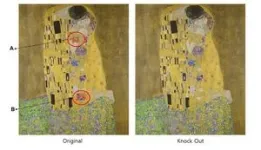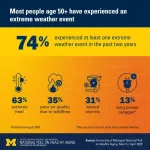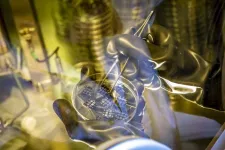(Press-News.org) Professor Im Joo Rhyu, director of the Korea University Graduate Program for Convergence & Translational Biomedicine and faculty member in the Department of Anatomy, recently led a study investigating the medical and artistic significance of the red, blood cell-like forms in Gustav Klimt’s The Kiss. Collaborating with Professors Hyunmi Park, Dae Hyun Kim, and Hwamin Lee from Korea University College of Medicine (KUCM) and Sungkyunkwan University Master's student Daeun Kwak, the research team delved into medical literature from Klimt’s fin de siècle era—the turn of the 19th into the 20th century—to uncover why these striking red discs found their way into the artist’s most iconic work.
A close examination of The Kiss reveals clusters of red, disc-shaped forms on the woman’s chest and knees—shapes that, to a medical eye, strikingly resemble red blood cells. These elements breathe vitality into the painting, intertwining the biological function of red blood cells with the psychological intensity of the colour red. The study proposes that the lovers’garments narrate a three-day cycle of life’s creation, enriched with physiological symbolism.
One key historical link is Karl Landsteiner, the Nobel Prize-winning scientist who discovered the ABO blood group system. His groundbreaking 1901 paper appeared in the Austrian medical journal Wiener Klinische Wochenschrift, where Professor Emil Zuckerkandl—a close friend of Klimt—served on the editorial board. Notably, in 1903, at Klimt’s request, Zuckerkandl delivered an anatomy lecture for artists, shaping Klimt’s evolving artistic approach (Dissecting Klimt, Im Joo Rhyu, 2024). Furthermore, Klimt is known to have owned a widely circulated German encyclopaedia, Meyers Großes Konversations-Lexikon, which featured colour illustrations of blood cells—suggesting that such imagery may have influenced his work.
Further reinforcing this interpretation, the woman’s arms in The Kiss form a shape reminiscent of a heart. The red discs on her chest appear strategically placed near this symbolic heart, evoking the rhythmic pulse of life coursing through her body and the new life she carries. Meanwhile, the red discs on her knee seem to represent menstrual blood—a subtle yet powerful emblem of fertility and reproductive vitality. This suggests that Klimt deliberately incorporated menstruation as an intrinsic element of human development, elevating it to a central motif within his visual narrative.
To examine the impact of these red, blood cell-like forms, the research team created a modified version of The Kiss, titled Kiss, RBC Knockout Kiss, in which the red discs were removed. They then surveyed 300 visitors at the 2022 Ulsan International Art Fair (UiAF), presenting both the original and altered versions. Viewers described the original painting with words like intensity, splendour, vitality, beauty, and young love, whereas the modified version evoked impressions of monotony, stillness, and lifelessness.
Professor Rhyu remarked, “Klimt’s The Kiss is a masterpiece that not only captures the ecstasy of love but also seamlessly weaves together art and medicine.”He added, “By transforming the scientific knowledge of his time into an artistic metaphor, Klimt created a work that continues to mesmerise audiences. The fusion of science and culture remains not only relevant but essential in shaping our understanding of both art and the human experience.”
This research builds upon the team’s earlier study, published in the prestigious Journal of the American Medical Association (JAMA) in 2021, which explored human developmental symbolism in The Kiss. That study concluded that the patterns and motifs in the figures’garments metaphorically represent sperm, eggs, and fertilisation.
The findings of this latest study were published in the Journal of Korean Medical Science under the title “Medico-Artistic Analysis of Red Blood Cells in Gustav Klimt’s The Kiss.” (10.3346/jkms.2025.40.e19)
END
The hidden anatomy of the kiss: Klimt’s red discs through a medical and artistic lens
A medical and artistic analysis of the red discs in the iconic painting
2025-03-20
ELSE PRESS RELEASES FROM THIS DATE:
Colorectal cancer linked with increased risk of cardiovascular mortality
2025-03-20
People diagnosed with colorectal cancer are significantly more likely to die of cardiovascular causes than the general population, especially in the first two years after their cancer diagnosis and in people younger than 50, according to a study being presented at the American College of Cardiology’s Annual Scientific Session (ACC.25).
With colorectal cancer on the rise in the United States, the study is the first to track rates of cardiovascular mortality and assess how risk changes over time. While the reasons for the linkage are not yet known, researchers say ...
Ovary removal increases heart failure risk
2025-03-20
Women of childbearing age who had both ovaries removed, in a procedure called bilateral oophorectomy, were more likely to develop heart failure later in life, according to a study being presented at the American College of Cardiology’s Annual Scientific Session (ACC.25).
Bilateral oophorectomy is often recommended to treat and, in some cases, prevent certain health issues, including endometriosis, pelvic inflammatory disease, heavy bleeding and ovarian cancer. The new study sheds light on the potential and unique role that this procedure might play in heightening cardiovascular risk given that it abruptly stops ...
A smarter way to track heart health with your smartwatch?
2025-03-20
The answer to your heart health may be on your wrist, a new study suggests. Researchers have developed a new way to assess cardiovascular health based on information routinely collected by smartwatches, according to a study being presented at the American College of Cardiology’s Annual Scientific Session (ACC.25).
According to the findings, dividing the average daily heart rate by the number of steps taken per day provides a more reliable indicator of a person’s cardiovascular fitness compared with either heart rate or step count alone.
“The metric we developed looks at how the heart responds to exercise, rather than exercise itself,” said Zhanlin Chen, ...
AI-powered mammograms: a new window into heart health
2025-03-20
Mammograms, with the help of artificial intelligence (AI) models, may reveal much more than cancer, according to a study being presented at the American College of Cardiology’s Annual Scientific Session (ACC.25). The findings highlight how these important cancer screening tools can also be used to assess the amount of calcium buildup in the arteries within breast tissue—an indicator of cardiovascular health.
The U.S. Centers for Disease Control and Prevention recommends that middle-aged and older women get a mammogram—an X-ray of the breast—to screen for breast cancer every one or two ...
First Comprehensive Stroke Centers certified in India
2025-03-20
DALLAS, March 20, 2025 — Stroke is the fourth leading cause of death in India and the fifth leading cause of disability.[1] To establish a coordinated system of care for stroke in the country, Apollo Hospital in Hyderabad, Telangana, and Aster Hospital in Calicut, Kerala, are the first in India to be certified as Comprehensive Stroke Centers by the American Stroke Association.
Launched in India last year, certifications from American Stroke Association, a division of the American Heart Association, devoted to a world ...
Weather emergencies affect older adults’ views on climate and health
2025-03-20
Nearly 3 out of every 4 older Americans have experienced at least one extreme weather event in the last two years, a new University of Michigan poll finds. And living through such an event appears to make a big difference in how they view the potential impact of climate change on their health.
The new findings from the National Poll on Healthy Aging show that 59% of people aged 50 and over are concerned about how climate change could affect their health.
The percentage expressing concern was even higher among those who had recently lived through a weather ...
Graz University of Technology team decodes heat conduction of complex materials
2025-03-20
Complex materials such as organic semiconductors or the microporous metal-organic frameworks known as MOFs are already being used for numerous applications such as OLED displays, solar cells, gas storage and water extraction. Nevertheless, they still harbour a few secrets. One of these has so far been a detailed understanding of how they transport thermal energy. Egbert Zojer’s research team at the Institute of Solid State Physics at Graz University of Technology (TU Graz), in collaboration with colleagues from TU Vienna and the University of Cambridge, has now cracked this ...
Cell atlas of the endometrium in women with PCOS may lead to better treatment
2025-03-20
Women with polycystic ovary syndrome (PCOS) find it harder to get pregnant, have more frequent miscarriages and have a higher risk of developing endometrial cancer. Now, in a new study published in Nature Medicine, Swedish researchers have shown that the uterine lining of these women differs in terms of both the composition of individual cells and gene expression. The results open the door to new drug treatments.
PCOS is the most common hormonal disorder affecting 11-13% of women of reproductive age. Women with the syndrome have difficulty getting pregnant and are at increased ...
New rules for the game of memory
2025-03-20
As animals experience new things, the connections between neurons, called synapses, strengthen or weaken in response to events and the activity they cause in the brain. Neuroscientists believe that synaptic plasticity, as these changes are called, plays an important role in storing memories.
However, the rules governing when and how much synapses change are not well understood. The traditional view is that the more two neurons fire together, the stronger their connection becomes; when they fire separately, their connection weakens.
New research ...
A simple way to control superconductivity
2025-03-20
Scientists from the RIKEN Center for Emergent Matter Science (CEMS) and collaborators have discovered a groundbreaking way to control superconductivity—an essential phenomenon for developing more energy-efficient technologies and quantum computing—by simply twisting atomically thin layers within a layered device. By adjusting the twist angle, they were able to finely tune the “superconducting gap,” which plays a key role in the behavior of these materials. The research was published in Nature Physics.
The superconducting gap is the energy threshold required to break apart Cooper pairs—bound electron pairs that enable superconductivity at low temperatures. ...
LAST 30 PRESS RELEASES:
University of Oklahoma researcher awarded funding to pursue AI-powered material design
Exploring how the visual system recovers following injury
Support for parents with infants at pediatric check-ups leads to better reading and math skills in elementary school
Kids’ behavioral health is a growing share of family health costs
Day & night: Cancer disrupts the brain’s natural rhythm
COVID-19 vaccination significantly reduces risk to pregnant women and baby
The role of vaccination in maternal and perinatal outcomes associated with COVID-19 in pregnancy
Mayo Clinic smartwatch system helps parents shorten and defuse children's severe tantrums early
Behavioral health spending spikes to 40% of all children’s health expenditures, nearly doubling in a decade
Digital cognitive behavioral treatment for generalized anxiety disorder
Expenditures for pediatric behavioral health care over time and estimated family financial burden
Air conditioning in nursing homes and mortality during extreme heat
The Alps to lose a record number of glaciers in the next decade
What makes a good proton conductor?
New science reporting guide published for journalists in Bulgaria
New international study reveals major survival gaps among children with cancer
New science reporting guide published for journalists in Turkey
Scientists develop a smarter mRNA therapy that knows which cells to target
Neuroanatomy-informed brain–machine hybrid intelligence for robust acoustic target detection
Eight SwRI hydrogen projects funded by ENERGYWERX
The Lundquist Institute and its start-up company Vitalex Biosciences Announces Strategic Advancement of Second-Generation fungal Vaccine VXV-01 through Phase 1 Trials under $40 Million Competitive Con
Fine particles in pollution are associated with early signs of autoimmune disease
Review article | Towards a Global Ground-Based Earth Observatory (GGBEO): Leveraging existing systems and networks
Penn and UMich create world’s smallest programmable, autonomous robots
Cleveland researchers launch first major study to address ‘hidden performance killer’ in athletes
To connect across politics, try saying what you oppose
Modulating key interaction prevents virus from entering cells
Project explores barriers to NHS career progression facing international medical graduates
Jeonbuk National University researchers explore the impact of different seasonings on the flavor perception of Doenjang soup
Two Keck Medicine of USC Hospitals named Leapfrog Top Teaching Hospitals
[Press-News.org] The hidden anatomy of the kiss: Klimt’s red discs through a medical and artistic lensA medical and artistic analysis of the red discs in the iconic painting




